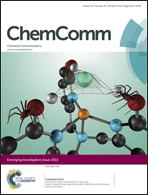Synthetic peptides caged on histidine residues with a bisbipyridyl ruthenium(ii) complex that can be photolyzed by visible light†
Abstract
We report a light-sensitive histidine building block for Fmoc/tBu solid-phase peptide synthesis in which the imidazole side chain is coordinated to a ruthenium complex. We have applied this building block for the synthesis of caged-histidine peptides that can be readily deprotected by irradiation with visible light, and demonstrated the application of this approach for the photocontrol of the activity of Ni(II)-dependent peptide nucleases.

- This article is part of the themed collection: 2015 Emerging Investigators

 Please wait while we load your content...
Please wait while we load your content...